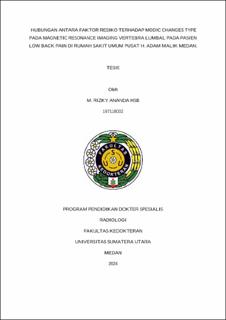| dc.description.abstract | Objective:
AnalyzeThe relationship between risk factors and modic change type on MRI of the lumbar vertebrae in low back pain patients at the H. Adam Malik General Hospital, Medan.
Method:
Cross sectional research that connectsmodic change type with risk factors and patient characteristics based on lumbar MRI examination in 120 patients diagnosed withLow back pain in 2023 that meet the inclusion and exclusion criteria. Modic Change Type is assessed based on the changes in Magnetic Resonance Imaging signals proposed by modic et al.
Results:
Of the 120 patients, there were more female subjects (64.2%) than male subjects (35.8%) with an average age of 58.96 years (the youngest was 40 years old and the oldest was 82 years old). Most subjects showed modic change (93.3%) with the most common type being type II (81.3%) and the most common location being L5 and L4. Most subjects also had disc herniation (72.5%) and disc degeneration (84.2%). This study did not find any relationship between modic change and gender (p=0.455), age (p=0.663), work history (p=0.671), disc herniation (p=0.213) and disc degeneration (p=1.000) in low back pain patients. From this study, there was no relationship between modic change type and gender (p=0.868), age (p=0.285), work history (p=0.130), disc herniation (p=0.510) and disc degeneration (p=0.435) in low back pain patients. From this study, there was no relationship between modic change location (L1, L2, L3, L4, L5, S1) and modic change type in low back pain patients with p>0.05.
Conclusion:
There is no significant relationshipbetween Risk Factors for Modic Changes Type in Magnetic Resonance Imaging of the Lumbar Vertebra in Low Back Pain Patients at H. Adam Malik General Hospital, Medan. | en_US |


